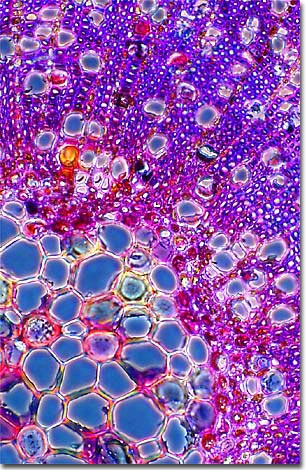Phase Contrast Image Gallery
Black Knot (Apiosporina morbosa)
The photomicrograph below illustrates a stained thin section of plum tree stem infected with Black Knot, a destructive disease of plum trees caused by the fungus Apiosporina morbosa (also known as Dibotryon morbosum). This fungus was first observed in 1821 in Pennsylvania, but can now be found throughout North America. The pathogen also affects apricot, peach, cherry and ornamental trees.

Within a year of infecting a tree, the fungus induces formation of galls on twigs and branches. Galls do not kill the tree immediately but continue to grow over the years. The enlarging galls stunt the tree's growth and cut off the flow of nutrients, weakening it and making it vulnerable to insect attack and other diseases, eventually killing the tree.
A. morbosa has two spore types. The conidia are produced through vegetative reproduction (self-cloning). Although they are part of the life cycle of the fungus, they are not involved with the disease process. Ascospores are produced through sexual reproduction (fusion of gametes) and are responsible for causing the galls.
For centuries, naturalists have been intrigued by the strange growths, or galls, they've observed on the stems, leaves, flowers and roots of plants. These neoplasms, or tumors, develop in response to attacks by other organisms and come in an astounding array of colors, shapes and sizes. Many plants form galls to ward off the attacks of bacteria, fungi, mistletoe, mites, nematodes, viruses, and insects. Remarkable fossil galls have been found on pine trees and extinct ferns dating back more than 200 million years. Although most galls probably do not harm the host, they do involve some form of parasitism and generally do not benefit the host.
BACK TO THE PHASE CONTRAST GALLERY
